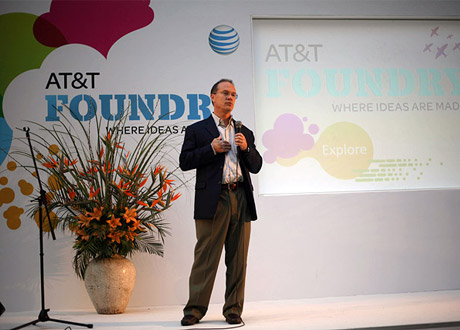By: Gianluigi Cuccureddu
This week AT&T opened up the third “Foundry” collaborative center in Palo Alto. The other two are situated in Plano, Texas and Israel. The AT&T Foundries are fast-paced and collaborative environments where AT&T and technology providers team with developers to deliver the latest applications and services to customers more quickly than ever before. By doing so, it increases velocity and a broader range of innovation three times faster.
The AT&T Foundries are one part of its overall innovation strategy. Their aim is to accelerate development through collaborative innovation, with external stakeholders such as venture capitalists, technology providers and venture capitalists.
AT&T Chief Technology Officer John Donovan said:
“The AT&T Foundry is a core component of our innovation strategy. This isn’t a technology showroom or testing facility. It’s a place where real innovation is occurring at an unprecedented pace in order to bring new services and products to our customers in a fraction of the time.”
The Palo Alto center is sponsored by Ericsson, Håkan Eriksson, group Chief Technology Officer and president of Ericsson said:
“AT&T and Ericsson are working to transform the way telecom companies develop concepts that will form tomorrow’s networked society. AT&T is actively engaged with us to combine local insights with global ecosystems to help entrepreneurs bring innovative ideas to market as quickly as possible.”
Consumer involved innovation?
The persuit by AT&T in collaborative innovation for the purpose of faster and more effective development cycles is interesting, but what about the role of the consumer within their open innovation?
Consumer involvement in the collaborative innovation wasn’t mentioned in the announcement. Whilst the three-time-faster pace is interesting, it doesn’t neccesarily say something about the effectiveness and adaptiveness by the target audiences.
In a recent article by Eric von Hippel on MIT Sloan’s website, research state that the consumer is a group of external stakeholders that can enhance innovation cycles:
“Recent research shows that consumers collectively generate massive amounts of product innovation. These findings are a wake-up call for both companies and consumers — and have significant implications for our understanding of new product development”.
In a survey by Harvard Business Review they found that:
Customer suggestions are the most important source of new product ideas.
- Half of the companies surveyed said increasing the rate of innovation is a top priority in 2011.
- IT is a key enabler of new product development processes and outcomes.
- Customer suggestions are the most important source of new product ideas.
- New product development is a team sport. More than half of the companies said marketing,
operations, sales, and finance work with the R&D department. - Fifty-five percent said partners are an important source of ideas and innovation support.
- Forty-three percent said intellectual property protection is a challenge in working with external organizations.
Also in this survey, the power of consumers is prominent.
Social Media technologies and data
To open up the innovation process towards consumers as well, there are different social media technologies available to keep the development cycle at pace. These technologies are cost-effective and can gather massive insights quickly.
In an indirect involvment, Social Media data contains lots of insights that can be used to get a better idea of the consumer, the productportfolio, market and competitors. This stream of information enriches the current decision-making and course of development as well.
Effectiveness
Depending on the level of product (Kotler), as explained here, AT&T and others can go towards the core (benefit) and execute intrinsic customer-centric innovation, which increases the effectiveness and adaptiveness towards the target audience.
Collaborative innovation results
Next to the increased speed-to-market, collaborative innovation will also improve the output-to-market. This will be even better by involving the consumers with continuous feedback loops throughout the development process.
The cost-to-market decreases when consumers are involved. Throughout the process they become advocates for the brand and product. A co-launch benefits of this advocacy when releasing the product through word-of-mouth/social media marketing and decreases dependancy on advertising and agencies.
By Gianluigi Cuccureddu
About the author:
 Gianluigi Cuccureddu, contributing editor, is an experienced writer specializing in innovation, open business, new media and marketing. He is also Managing Partner of the 90:10 Group, a global Open Business consultancy, which helps clients open their activity directly and indirectly to external stakeholders through the use of social media, its data and technologies for the purpose of competitive advantages in marketing, service- and product innovation.
Gianluigi Cuccureddu, contributing editor, is an experienced writer specializing in innovation, open business, new media and marketing. He is also Managing Partner of the 90:10 Group, a global Open Business consultancy, which helps clients open their activity directly and indirectly to external stakeholders through the use of social media, its data and technologies for the purpose of competitive advantages in marketing, service- and product innovation.

